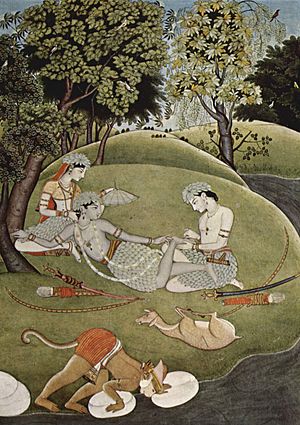Ramayana facts for kids
Quick facts for kids Ramayana |
|
|---|---|

|
|
| Information | |
| Religion | Hinduism |
| Author | Valmiki |
| Language | Sanskrit |
| Verses | 24,000 |
The Ramayana is a very old and famous story from India. It's an epic poem written in Sanskrit, an ancient language. It tells the adventures of Rama, a prince. It's one of two big epic stories from India, the other being the Mahabharata. A wise man named Valmiki wrote the original Ramayana. It has many thousands of verses and is split into seven main parts.
The story of the Ramayana is about Prince Rama. He is sent away from his kingdom of Ayodhya. He then goes on a journey and fights the powerful king Ravana of Lanka in a long battle.
Many different versions of this story exist. It has been translated into almost all the major languages of the world.
Contents
What is the Ramayana?
The Ramayana is a long poem that tells a heroic story. It's considered a very important part of Hinduism. The story teaches about good and evil, duty, and love. It has influenced art, culture, and traditions across Asia for thousands of years.
The Seven Books of the Ramayana
The Ramayana is divided into seven main parts. Each part is like a different book or chapter in the story. These parts help tell Rama's journey from his childhood to his return home.
- The first book is Balakand, which means "the book of the childhood."
- The second book is Ayodhyakanda, meaning "the book of Ayodhya."
- The third book is Aranyakanda, meaning "the book of the forests."
- The fourth book is Kishkindakanda, meaning "the book of Kishkindha."
- The fifth book is Sundarakanda, meaning "the beautiful book."
- The sixth book is Yuddhakanda, meaning "the book of the war."
- The seventh book is Uttarakanda, meaning "the book of after events."
When Was the Ramayana Written?
People have different ideas about exactly when the Ramayana was written. Some think it was written about 2,500 years ago. Others believe it was around 1,800 years ago. Everyone agrees that it is a very old story. It was written even before the Mahabharata, another famous Indian epic.
The Ramayana's Lasting Impact
The Ramayana is still very popular today. Every autumn, people celebrate a festival called Dassehra. During this time, a special play called Ramlila (meaning Rama play) is performed. It tells parts of the Ramayana story. At the end of the festival, a huge model of Ravana is set on fire. This act shows the victory of good over evil, or light over darkness.
The story of Rama has traveled far beyond India. For example, a Tamil version was written by Kamban between the 9th and 10th centuries. It's called Iramavataram. In the 16th century, Tulasidas wrote a Hindi version called Ramacharitmanasa. Over many centuries, the Ramayana story reached countries like Indonesia and Malaysia. It has been translated into most major languages around the world.
In ancient India, the Ramayana was used to teach young children. It helped them learn about important Hindu beliefs. These beliefs include concepts like Brahman (the ultimate reality), multiple gods, Dharma (right conduct), Samsara (the cycle of rebirth), and Karma (actions and their results).
Images for kids
-
Rama (left third from top) depicted in the Dashavatara, the ten avatars of Vishnu. Painting from Jaipur, now at the Victoria and Albert Museum
-
A gold carving depiction of the legendary Ayodhya at the Ajmer Jain temple.
-
Ravana fights Jatayu as he carries off the kidnapped Sita. Painting by Raja Ravi Varma
-
Sita with Lava and Kusha
-
The epic story of Ramyana was adopted by several cultures across Asia. Shown here is a Thai historic artwork depicting the battle which took place between Rama and Ravana.
See also
 In Spanish: Ramayana para niños
In Spanish: Ramayana para niños

















